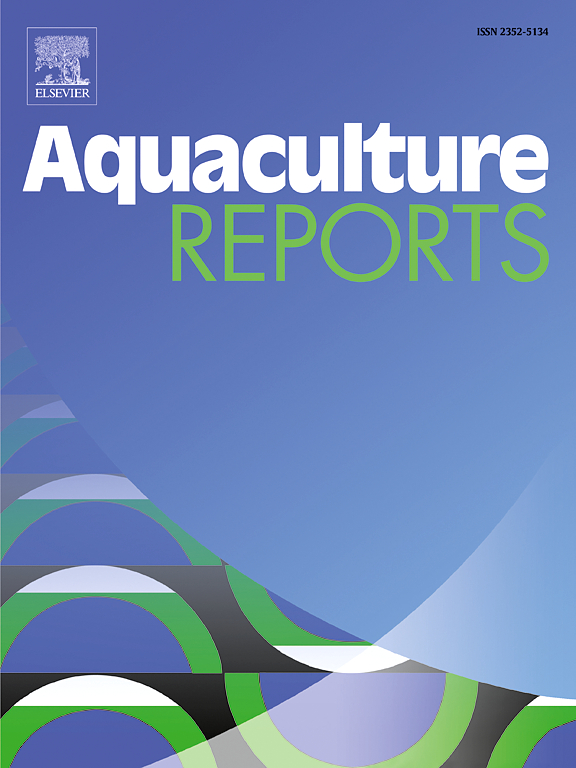为提高太平洋鲍鱼(Haliotis discus hannai)饲料效率特性而进行的新测量的禁食和再喂效果
IF 3.2
2区 农林科学
Q1 FISHERIES
引用次数: 0
摘要
为了加快鲍鱼饲料效率性状的测定过程,并将该技术应用于商业养殖计划,我们建立了一种新的评价指标,即禁食复喂处理。随机抽取10月龄太平洋鲍鱼(Haliotis discus hannai) 400只。为了评估饲料效率性状,采用先前建立的单个体系统对每只鲍鱼进行了72天的培养。然后,剔除异常值后对FER进行排序,将前150和后150个体分别暴露于不同的禁食应激持续时间(3、7、10、14和21天),然后进行单个体重新喂食处理。在此过程中,记录了每只鲍鱼的体重波动情况。分析高饲料效率组和低饲料效率组应对禁食应激和再饲喂能力的差异。研究结果表明,不同禁食时间后,高、低fer组太平洋鲍鱼的特定减重率(SWLR)不同。FER与体重变化指数的相关分析结果显示,应激时SWLR与FER呈负相关,其中禁食7 d组(S7)相关性最高(r = -0.71)。补饲的“快速生长期”与饲料质量呈正相关,其中禁食10 d组(S10)第14-28天体重增重(BWG)与饲料质量的相关性最高(r = 0.79)。结果表明,鲍鱼对禁食应激和复饲的抵抗能力存在显著差异,这与饲料效率有关。上述测定指标(S7组的SWLR和S10组的BWG14-28)可作为饲料效率性状的间接指标,在鲍鱼养殖中具有应用价值。本文章由计算机程序翻译,如有差异,请以英文原文为准。
Fasting and re-feeding effects for the new measurement to improve feed efficiency traits in Pacific abalone (Haliotis discus hannai)
To speed up the process of measuring abalone for feed efficiency traits and apply the technique in commercial breeding programs, we developed a new evaluation index by fasting and re-feeding treatment. A total of 400 ten-month-old Pacific abalone (Haliotis discus hannai) were randomly sampled. To evaluate feed efficiency traits, each abalone was cultured for 72 days using the previously established single-individual system. After that, the FER was ranked after removing outliers, the top and bottom 150 individuals were exposed to different durations of fasting stress (3, 7, 10, 14, and 21 days), which was followed by single-individual re-feeding treatments. The fluctuations in body weight of each abalone during this process were recorded. The difference in the ability to cope with fasting stress and re-feed between the high- and low-FER (feed efficiency ratio) groups was analyzed. The findings demonstrated that the specific weight loss rate (SWLR) of the high- and low-FER groups of Pacific abalone differed after varying durations of fasting. The results of the correlation analysis between FER and weight change index showed that SWLR was negatively correlated with FER during stress, and the correlation of the 7-day fasting group (S7) was the highest (r = –0.71). The “rapid growth stage” during re-feeding was positively correlated with FER, and the correlation between the body weight gain (BWG) of days 14–28 and FER in the 10-day fasting group (S10) was the highest (r = 0.79). The results indicate that there is significant variation in the capacity of abalone to resist fasting stress and re-feeding, and this is associated with feed efficiency. The above measured indicators (SWLR of the S7 group and BWG14–28 of the S10 group) may be used as indirect indicators for feed efficiency traits, and these indicators have application value in abalone breeding.
求助全文
通过发布文献求助,成功后即可免费获取论文全文。
去求助
来源期刊

Aquaculture Reports
Agricultural and Biological Sciences-Animal Science and Zoology
CiteScore
5.90
自引率
8.10%
发文量
469
审稿时长
77 days
期刊介绍:
Aquaculture Reports will publish original research papers and reviews documenting outstanding science with a regional context and focus, answering the need for high quality information on novel species, systems and regions in emerging areas of aquaculture research and development, such as integrated multi-trophic aquaculture, urban aquaculture, ornamental, unfed aquaculture, offshore aquaculture and others. Papers having industry research as priority and encompassing product development research or current industry practice are encouraged.
 求助内容:
求助内容: 应助结果提醒方式:
应助结果提醒方式:


